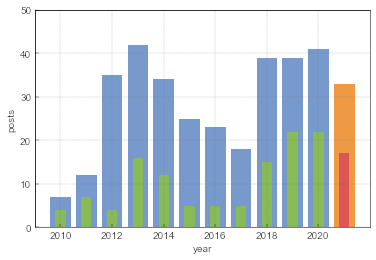We have started the year by finishing the series of posts on the anomalous
diffusion in voter model. The series featured one
more recent endeavor with Rytis Kazakevičius and one
"forgotten" paper written for my postdoctoral
project. We also went back to the topic of the
opinion dynamics and have talked about supportive
interactions and partisan voting. We
have finished the year by exploring various time series models leading us up
to ARFIMA model.
All in all, Physics Risk had 33 posts in 2021 (-8 posts in comparison to
2021). 17 of the posts were filled under interactive
models tag.
I guess my tempo is dropping a bit as I am running out of easy to make and
interesting enough material. Some of the things I am doing now are not easy
to implement in JavaScript (even in C/Python I have to rely on 3rd-party
libraries to do the heavy-lifting stuff) and to show off to the broader
public in the usual Physics of Risk style. And while there are interesting
things I could still show you, most of them are not of the immediate
interest to me, so it is hard to find strength and time to continue. I guess
a new style will need to be invented.

